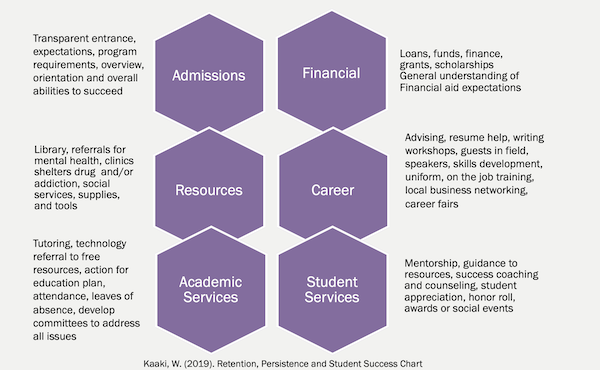Published on
Understanding and Supporting Retention, Persistence and Student Success for CTE Students

Career and Technical Education (CTE) concentrates on developing specific professional skills through hands-on experience. It offers a flexible and accelerated schedule that makes training accessible for all learners, despite their age or personal commitments.
Career colleges are under pressure to meet the demands of their student populations as well as fulfill the requirements set by accrediting bodies. These colleges are also facing challenges with retention, persistence and student success.
The current body of research, however, shows a gap in studies about student success rates, retention and persistence rates in CTE. It is difficult to gather accurate and replicable data, especially because CTE programs take different forms, often offered at lengths than traditional programs. That makes it more difficult to make patterns, predictions or connections in the data. For example, existing data for traditional two- and four-year programs may not be applicable to CTE programs, which can last from six to nine months.
To quickly define (and differentiate) persistence rate, retention rate and student success:
- Persistence rate: percentage of students who attend college and complete a credential within a designated timeframe at the same institution.
- Retention rate: percentage of students who attend college and stay enrolled at the same college for the next year at the same institution.
- Student Success: Favorable student outcomes
Studies suggest using at least a one-year observation period for persistence and retention rates. Shorter programs—such as nine-month certificates—require even more monitoring to ensure the persistence and retention time is not exceeding the time allotted to complete.
Accelerated programs are becoming increasingly common. We’re seeing more competency-based programs on the market, for example. This means quicker actions need to be taken for students finishing faster. After all, even though their tuition may not be higher, they are still a part of the completion ratio, budget and practice.
Student Success From Different Perspectives
From an accountability standpoint:
Colleges set benchmarks to hold themselves accountable for student success and ensure a student-centered approach.
From a student standpoint:
From a student view, success means employment, skills, training, application of the hands-on knowledge attained in the program, more money to earn or for self-gratification.
From a programmatic standpoint:
Success means ensuring programs and curricula are current and up-to-date in the particular business or trade, and that close contact is being maintained with local and global businesses. It also means making necessary materials, tools, supplies, books, and guides needed to supplement the curriculum accessible. Importantly, it means creating mechanisms to consciously engage with students from Day 1 until graduation and staying in touch with alumni.
According to the National Student Clearinghouse (2016), in 2015, 73.9% of students persisted at any U.S. institution (including career colleges) while 60.6% were retained at their starting institution.
These results indicate that students in postsecondary institutions are finishing or completing programs, but this does not imply that they stay at the same institutions where they initially enrolled.
This becomes especially important when accrediting bodies make decisions based on completion rates. These data tend not to take into account students’ swirling pathways to completion, which can be advantageous for colleges that take on new students and retain them through graduation, but disadvantageous to colleges with a transfer mission. It could be particularly interesting for institutions to begin to research or track the students who leave before earning a formal credential. Did they choose other programs? Did they elect to pursue a degree versus a certificate? This information can be essential to supporting student success.
The following is chart on the some of the minimal practices recommended to ensure and address each area relevant to retention, persistence and student success:
Identify your student population and create plans to address all student needs.
Some ideas to support persistence, retention and success for your CTE students:
- Develop a committed committee on retention.
- Hold (useful!) weekly meetings that address every single student. These meetings can cover attendance, grades and benchmarks as well as encourage higher standards and expectations.
- Be the best you can be; mediocre is not good enough.
- Set up a rewards system, make contracts and involve students and the team.
- Call, e-mail and even text students to actively engage them.
- Create events for students and their families.
- Be involved with the instructors—they are students’ day-to-day contacts and have first-hand communication with the students.
- Treat instructors well. Train, support, and compensate them fairly. Satisfied instructors are invaluable and work beyond the curriculum.
- Create assessment boot camps and crash courses, mainly in nursing or for other certifications exams.
Retention, persistence and student success looks promising for the future. In the years ahead, CTE could involve more online courses with better interactive components as well as state-of-the-art hands-on practice within the classroom, advanced simulation activities, employer-initiated programs, and a growth in internship relationships for out-of-state applicants.
We must continue to address retention, persistence and student success while CTE programs continue to evolve and advance.
Author Perspective: Administrator




